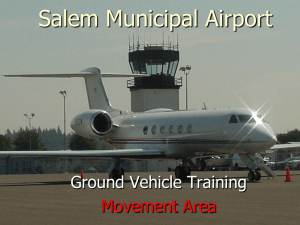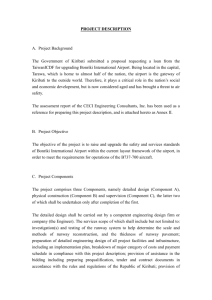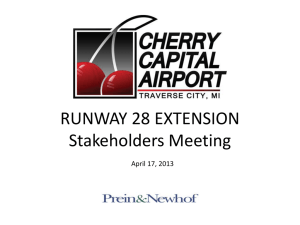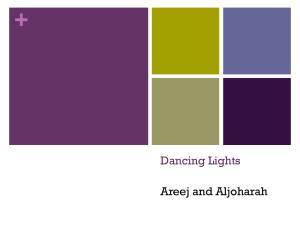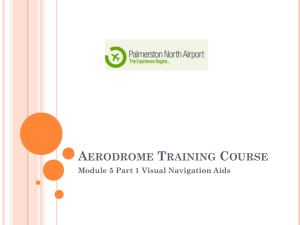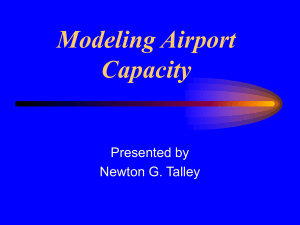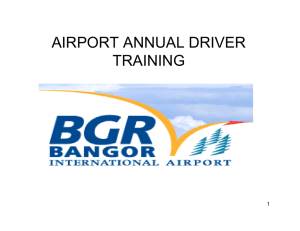TRANSPORTATION_EMERGENCIES(AIRPORT)
advertisement
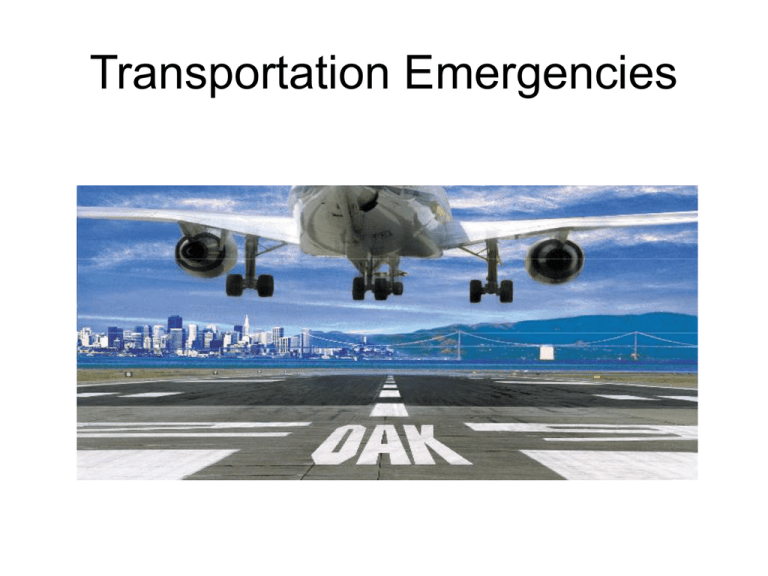
Transportation Emergencies Modes of Transportation Modes of Transportation • There are many different modes of public transportation. Which modes of public transportation operate within our area? • It is important that you be prepared to respond to any of these types of incidents. Airport Familiarization – In this module, we will learn the established procedures for movement within airports. This module will include: – Color code system for airport lighting – Established procedures and verbal communication as used by Air Traffic Control. – Runway and Taxiway designation systems. Airport Familiarization • By being thoroughly familiar with the airport facility, emergency personnel can respond to the accident/incident quickly, thereby increasing the effectiveness of the rescue and fire fighting effort. Runway Designation Systems • Runway numbers are taken from the nearest compass bearing rounded off to the nearest 10 degrees. A runway with a compass heading of 340 degrees is numbered 34 for aircraft approaching from the south. (Shown Here) Runway Designation Systems • Taxiways are usually designated by letters, a combination of numbers and letters, or names. Lighting and Marking Systems Lighting and Marking Systems • In addition to runway numbers and taxiway identification systems, colored lights and other markings are used to identify various areas, buildings, and obstructions at airports. Rescue personnel should understand the lights and marking system used on their particular airport. Lights • While taxiway designations vary from airport to airport, runway and taxiway lighting is standard at all airports. Lights • Blue Lights are used to outline taxiways and are usually located along the edges, about 100 feet apart. • White Lights are used to outline the edges of runways, with lights spaced 200 feet apart, and to identify runway centerlines, with lights spased 50 feet apart. • Green Lights are used to identify the approach end of runways and taxiway centerlines • Red Lights are used to mark obstructions and runway ends. • Amber Lights are used to identify locations of hold bars, which are areas that require permission from the control tower to cross. Taxiway Lights Runway Lights Markings • White is used for runway identifier numbers/letters, landing zone bars, and centerline stripes. • Yellow is used for hold bars and taxiways. A hold bar is like a stop sign for all vehicles or aircraft using the taxiways. Hold Bars • One side of the hold bar is a solid line, and the opposite side is a dashed or broken line. When approaching a hold bar from the solid-line side, the vehicle or aircraft is required to stop until either visual clearance is confirmed or the tower has approved further movement. When approaching from the dashed-line side, the hold bar is not applicable. Airport Ground Vehicle Control Airport Control • Uncontrolled airports are those that do not have a staffed and operating control tower., and controlled airports are those that do. • At controlled airports, control tower personnel issue clearances, instructions, and information to vehicles in aircraft operating areas, so vehicle driver/operators must be in radio or visual contact with tower ground control. • Although two-way radio is much more reliable and efficient, the tower may also control movement areas through light signals. Airport Light Signals • Flashing Green Light. Clear to proceed across or down the runway. • Steady read light. Stop! Do not proceed. • Flashing red light, Flashing runway lights. Clear active runway IMMEDIATELY! • Flashing white light. Return to fire station • Alternating green/red flashing light. General warning, use caution. Verbal Communication • The following sample vocabulary is not all inclusive but is representative of the words and phrases in most common usage in the airport environment. To be effective in radio communication, personnel must be thoroughly familiar with these terms and their meanings. Vocabulary • Acknowledge - Confirm that you have received and have understood the message. • Advise intentions - Explain what you plan to do. • Affirmative - Yes, permission granted, or that is correct • Base leg - Aircraft on a 90-degree approach to the landing runway • Broadcast - Transmission of information for which an acknowledgement is not expected. Vocabulary • Confirm - Verify or recheck • ETA - Estimated time of arrival • Expedite - Prompt compliance is required • Missed approach - A maneuver executed by a pilot whenever a final approach cannot be completed into a landing. • Wilco - Indicates that an order or request will be complied with. This concludes Airport Familiarization

